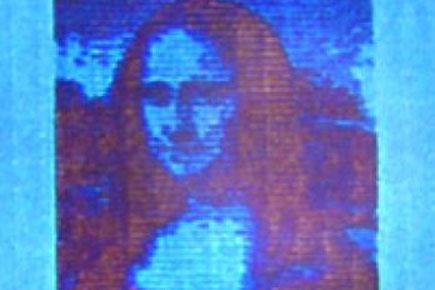Using new nanotechnology, researchers have reproduced a colour image of Mona Lisa which is less than one pixel on an iPhone Retina display -- 50 micrometres long or about 10,000 times smaller than the real Mona Lisa in the Louvre Museum in Paris

Microscopic Mona Lisa
London: Using new nanotechnology, researchers have reproduced a colour image of Mona Lisa which is less than one pixel on an iPhone Retina display -- 50 micrometres long or about 10,000 times smaller than the real Mona Lisa in the Louvre Museum in Paris.
The breakthrough revolutionises laser printing technology, allowing people to print high-resolution data and colour images of unprecedented quality and microscopic dimensions.
ADVERTISEMENT

A microscopic Mona Lisa. She is 50 micrometres long or about 10,000 times smaller than the real Mona Lisa in the Louvre in Paris. (Photo: Technical University of Denmark (DTU)
The new laser technology allows printing in a mind-blowing resolution of 127,000 dots per inch (DPI). In comparison, weekly or monthly magazines are normally printed in a resolution equivalent to 300 DPI.
The team from Technical University of Debmark (DTU) believe that there is considerable scope for application of the new laser printing technology.
"It will be possible to save data invisible to the naked eye. This includes serial numbers or bar codes of products and other information. The technology can also be used to combat fraud and forgery as it will be easier to determine whether the product is an original or a copy,” explained professor Anders Kristensen from DTU Nanotech.
Printing the microscopic images requires a special nanoscale-structured surface.
The structure consists of rows with small columns with a diameter of merely 100 nanometres each.
This structured surface is then covered by 20 nanometres of aluminium.
When a laser pulse is transmitted from nanocolumn to nanocolumn, the nanocolumn is heated locally, after which it melts and is deformed.
The temperature can reach up to 1,500 degree Celcius but only for a few nanoseconds, preventing the extreme heat from spreading.
Strong laser pulses create a drastic deformation, which gives the reflection from the nanocolumn an orange and yellow colour tone.
The new laser printing technology can also be used on a larger scale to personify products such as mobile phones with unique decorations, names, etc.
Foreign companies producing parts for cars, such as instrument panels and buttons, are already taking a keen interest in the technology as it can simplify the production.
The breakthrough in nanotechnology was detaild in the journal Nature Nanotechnology.
 Subscribe today by clicking the link and stay updated with the latest news!" Click here!
Subscribe today by clicking the link and stay updated with the latest news!" Click here!







